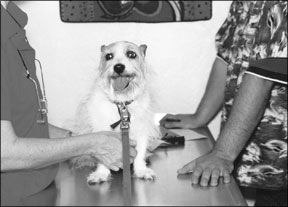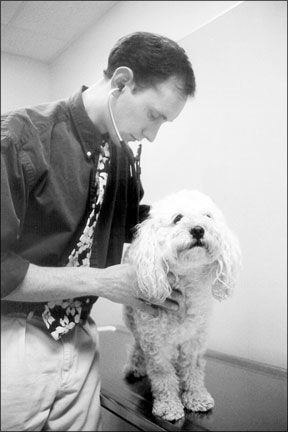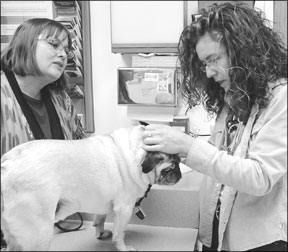Randy Boucher of Philadelphia took his new Rhodesian Ridgeback puppy on her first veterinary visit armed with a binder full of diet and vaccine recommendations from his holistically oriented dog breeder.
But instead of a conversation about raw feeding and minimal vaccination, he got a rant.
“The vet told me my breeder was a crackpot, and that he totally disagreed with what she wanted me to do,” Boucher remembers. “And he said Mosa was underweight and that I should put kibble in her bowl and let her eat as much as she wanted for 15 minutes” advice that for ever-ravenous Ridgies is a one-way ticket to dog obesity.
Angry and upset, Boucher picked up his brown-nosed girl and headed out the door. Later that day, he called his “crackpot” breeder who, in the interest of full disclosure, happens to be me!
I promised that a remedy was only a few keystrokes away, and it was: In response to my e-mailed plea, several fellow breeders on a Ridgeback Internet forum recommended a homeopathic vet in nearby Delaware whose attitudes about dog nutrition and vaccination exactly mirror the way Mosa was reared. Though the new vet isn’t as conveniently located as the first, the half-hour drive to Wilmington is a small price to pay for a kindred spirit.

Vet visits shouldn’t be traumatic, for the dog or the owner. And while Mosa’s story has a happy ending and most vet visits aren’t as harrowing as her inaugural one many owners who want to pursue a more holistic approach find themselves in a quandary over how to deal with the second-most important human relationship in their dog’s life: the one with their vet.
“That old paternalistic and maternalistic view of medicine is still there, particularly in older practitioners. There is this idea of ‘Do this because I say so, and don’t ask questions,’” says veterinarian Myrna M. Milani of Charlestown, New Hampshire, author of The Art of Veterinary Practice: A Guide to Client Communication, (University of Pennsylvania Press, 1995). Thankfully, as with human medicine, veterinary care is evolving, and “there has been a shift to a new, patient-centered form, and in that realm the owner becomes the animal’s advocate.”
It’s getting there that can be difficult.
It’s more emotional
Chances are your interactions with your auto mechanic or accountant are straightforward and uncomplicated unless, of course, your car keeps stalling or the IRS comes calling, in which case you move on.
But your relationship with your vet is likely more complex, for a couple of reasons: The art of medicine is not as linear as adding up a column of numbers; negotiating your options is very subjective, and sometimes touchy, especially if your vet isn’t supportive of holistic modalities you might be inclined to try. And while you may love your VW Bug beyond measure, triangulating yourself between a vet’s professional opinion, the fate of your furry mop-top, and your own ideas about the right approach can bring with it a range of turbocharged emotions more appropriate for a therapist’s couch than a stainless-steel exam table.
Randye DeLorto, a Rottweiler breeder from Hemet, California, says the handiest metaphor she can think of is marriage.
“Like any marriage, you have to work at it, and vets can be high maintenance,” she says. “My vet knows I’m a breeder, and he knows I’m holistic, and we spar. I respect him for his thoughts, and I ask his opinion on other things. And I think he respects my knowledge and effort, and the fact that I don’t think the same way he does. That’s a good way to have any good working relationship or marriage.”
No relationship conjugal, veterinary, or otherwise is perfect. There will always be areas of tension and disagreement. In some cases, monogamy may not be the best option: Some owners might have to expand their circle of veterinary care to include specialty and holistic practitioners who have expertise where their primary vet doesn’t. All of this takes time, thought, and most important the willingness to be honest and open about what you are doing and why.
If you’re struggling with your relationship with your vet, or are considering finding a new one, here are some things to consider.
Do a cost-benefit analysis
Every vet-client relationship will have its rough patches; that’s just reality. The question to ask yourself, Milani suggests, is: “What am I getting from this person versus what I have to give up?” If your veterinarian is a brilliant diagnostician and surgeon, has top-notch equipment, keeps up on her continuing education, but is lukewarm about the fact that you feed a raw diet, consider whether that is enough to be a deal breaker.
What people value in a veterinarian can also vary wildly. “For some people, the most important thing is a vet they can communicate easily with,” Milani says. “For others, it’s state-of-the-art technology.” If you’re someone who places a premium on a relaxed, engaging bedside manner, no gee-whiz diagnostic machinery is going to make up for that. Figure out what matters to you, and see if you can forgive the rest.
Penny Mallen of Napa, California, is a case in point. Her equine vet is supportive of her decision to vaccinate her horses minimally, and to use homeopathic nosodes whenever possible. Her dogs’ vet is a different story.

“We lock horns on a regular basis regarding vaccination,” she says. “I send him all the articles that I see, and then he puts them in my file and we don’t talk about it.”
Despite the fact that her vet can get “feisty” and “argumentative,” they’ve agreed to disagree a process made easier, Mallen admits, by the influence of her vet’s wife, who also happens to be the aforementioned equine vet.
“In all honesty, I haven’t found anyone any better,” she says. “He’s a wonderful technician. I can call them at home. He’s fairly open-minded, and he likes his clients to be knowledgeable; he respects that. He’s willing to read and listen, and I think that’s the most important thing, even in the end if he doesn’t agree.” Bottom line: His pros outweigh his cons.
Respect in, emotion out
Part of the reason for Mallen’s success with her vet is that both are respectful: Mallen of her vet’s professional ability and training, and he of her position as final arbiter.
“I view all my relationships this way, whether it’s with my attorney or my doctor or even my husband,” she says. “If they are knowledgeable about the subject, I listen, but in the end I’m the one that has to make the decision that’s right for me. And for the most part, if I can eliminate emotion, it works better.”
Love, guilt, fear, sadness, resentment all those feelings can cloud your dealings with your vet and affect the treatment process. “We increasingly live in a society in which our relationships with our companion animals are driven by emotion rather than knowledge,” Milani says. And while that’s understandable, it’s not helpful, “because when you’re driven by emotion, that’s all you’ve got.”
As simple as it is to do, it may be difficult for some owners to set aside the various emotions that dealing with an authority figure dredges up whether fear or guilt or hostility and just deal honestly and straightforwardly with their veterinarians.
“Do you know that your vet is going to be offended” if you respectfully but firmly disagree with her opinion? Milani asks. “Or are you just afraid the vet is going to be offended?” Don’t make decisions based on “what ifs.”
Consider the culture
No matter what the species, medicine can be a rigid, hierarchical discipline where creative thinking and compassion the very things that draw idealists to the field are sometimes backburnered in the face of pragmatic considerations such as productivity and profitability.
Veterinarian John Robb of Fairfield, Connecticut, founder of Protect the Pets, a nationwide network of veterinary prac-titioners who have pledged to put the welfare of animals above the drive for profits, says veterinary culture is by its very nature resistant to change.
“There’s a lot of concern with protecting our image rather than embracing change in a much-changing world,” he says, noting that he felt pressured, even persecuted, when he decided to switch to a minimal vaccination protocol a decade before it was in vogue. This occurred again when he began to question the inordinate influence pharmaceutical and vaccine companies have on how veterinarians do business. “In that context, we do have a lot of vets who think they know more than they do, and egos get inflated,” he says.
While no one advocates kowtowing to a Dr. Doolittle with a Napoleon complex, clients can get more with honey or at least a little sweet talking. Veterinarians who are unaccustomed to having their authority challenged, or who interpret a client’s desire to follow a different protocol as criticism of their competency, can respond magically to a basic reaffirmation of their ability. Telling the veterinarian, “I know you’re a crackerjack allopathic vet and I’d like you to help me pursue holistic treatment for my dog,” tells her that you respect her knowledge base, and turns a potential conflict into a team effort.
“It’s like when you have kids,” Milani reminds. “There are times when for their sake you buck up and do something because it’s so important even if you have to fake it.”
Understand your vet’s unspoken concerns
The veterinary profession has already changed dramatically, Robb says, considering that until the 1950s veterinary medicine was mostly agriculture-oriented, and small-animal hospitals were unheard of. Today, awareness of the human-animal bond has taken root, but as an institution veterinary medicine is still often out of synch with it.
As an example, Milani points to the practice of not allowing an owner to hold an animal during an exam. “That’s an edict that comes down from the American Veterinary Medical Association,” she notes. Vets who choose to disregard this rule may be honoring their client’s relationship with their dog, but at a potential cost.
Like it or not, such liability concerns pay a large role in determining how a veterinarian will deal with requests that are outside his or her comfort level. You can help make that a moot issue by offering to sign a liability waiver. Or, reassure your vet by acknowledging his concerns, but reminding him that you take responsibility for the direction you are choosing, and reassuring him you won’t blame him if things don’t turn out as you envision.
“Ultimately, it’s the public that needs to spur on change by articulating what they want,” Robb reminds. By doing your part with your own veterinarian, you nudge the process a tiny bit further, one dog at a time.
Be honest
This should be obvious, but for many it’s not. As with our own personal relationships, we are sometimes tempted play games in order to avoid confrontation or unpleasantness.
“Where people get into trouble is they don’t tell the veterinarian who’s working the case up that they’re going to leave with the antibiotics and then throw them out because that’s not what they wanted in the first place,” Milani says. Not only does this undermine your relationship with your vet, but it could put your dog’s health in jeopardy. The same applies if you are freelancing herbs on the side and are unaware of their contraindications.
Furtively obtaining holistic treatment without telling your veterinarian also undermines the validity of what you’re doing, she adds. “To me, what you’re saying is you believe those holistic treatments have no power, that they’re not going to have any effect.”
Besides, just how long can you keep up the ruse? “The benchmark of the whole natural holistic movement is that none of these modalities are a quick fix,” Milani explains. “They all require commitment and involvement” something that’s impossible if you’re tiptoeing around.
Don’t rationalize
Milani notes that previous surveys by the American Veterinary Medical Association have consistently found that location is a prime criterion for choosing a vet. “People go to the one that’s closest until they have a bad experience. Then they’re willing to travel farther.”
Instead, be proactive. If your relationship with your vet is shaky, admit that to yourself, and either try to fix it or move on. “Where I see people get into trouble is that they know when they go to their vet that it’s not working for them, but they go into denial,” Milani says. “Every time they go, there is no communication, which can’t be good for the dog. Then when crisis strikes, they just react.”
The more difficult the conversation, the more important it is to have it before things get to a breaking point. Milani says end-of-life concerns are a common area where communication snafus can be devastating.
“There is nothing worse for the owner of a terminally sick or injured animal than to discover that their vet will not euthanize that animal,” she says. “To have been with a practice for years, and now, when you really want this person there, to find out they have a personal moral view that they didn’t share” that’s a surprise no one wants.
Do your homework
Like it or not, the burden is on you to evolve your relationship with your vet, and give it the fuel to grow.
“What really needs to happen is the vet has to embrace the client,” says Robb. To encourage your veterinarian to make that leap, “clients need to do research on their own, and present the vet with reliable research from a reliable source.”
Owners who are newly embarked on a holistic path often don’t have the confidence to stand up for the approach they want. “The key isn’t so much credentials,” says Milani, it’s informing yourself about what you want. “If my client has obviously done her homework, I will feel more confident about letting her try different options than if she seems to know nothing.”
The more lead time you can get on decision-making, the better. For example, when you call to make the appointment for your puppy’s first series of inoculations, ask the receptionist or a technician to de-scribe the practice’s standard vaccine protocol.
If, after more research, you decide you’d prefer a different approach, call back and inquire whether you have options on what vaccines to give. Doing more research such as finding out if your breed or particular line of dogs has a history of vaccine reactions will also bolster your case.
If you are very nervous about talking to your vet, jot down some talking points, practice them with a friend, or bring along another person for support.
Bring in outside expertise
DeLorto, who’s fond of her marriage metaphor, went to her conventional vet six years ago “already having other suitors,” she says with a wink. The consultant she selects depends on her needs.
For example, she sends all her bloodwork to veterinary immunologist Jean Dodds in Santa Monica, California. She has a holistic vet who she turns to for chiropractic and kinesiology. And there’s another conventional vet who is open to holistic modalities, but whose policy of not taking appointments makes her less convenient.

Even if your vet labels herself “holistic,” that won’t necessarily save you from having to take a more buffet approach to your dog’s care: “Holistic” covers a yawning spectrum, from the mostly conventional vet who is certified in chiropractic but only turns to it for textbook cases, to the naturopath who uses kinesiology to diagnose problems over the phone.
Referrals are another option, says veterinarian Anna Worth, owner and medical director of West Mountain Animal Hospital in Shaftsbury, Vermont, and vice president of the American Animal Hospital Association. “If we have someone who doesn’t want to give his dog Rimadyl [for arthritis pain], or wants to try something else instead of chemotherapy for cancer, we have a very good homeopathic vet near us,” she says. “I think a vet has to be understanding of what that client wants.”
If you don’t have a holistic vet nearby, geography need not limit you: Many will do phone consults, as long as they can consult and work in conjunction with your local vet.
Robb notes that there is plenty of room for improvement, especially among general practitioners “who need to be more open-minded about holistic medicine.” He suggests that owners remind conventional vets who are skeptical or who have had a bad experience with what they term “quackery” that there are varying degrees of competency in every area. And ultimately, “the proof will be in the pudding” if the holistic approach is successful.
Milani notes that the more confident and capable a vet is, the more tolerant she’ll be of new ideas and approaches. “Vets who are comfortable with what they are doing are very open. They’ll say, ‘If I don’t know, I’ll find out’ or ‘If you feel strongly about this, I’ll find someone to help you.’ They’re not threatened.”
If all this sounds like a lot of work, it is. “You have the same problem with your own health care,” Worth reminds. “You have to be proactive.”
Rely on word of mouth
As Boucher’s story illustrates, turning to dog-savvy people you trust including pooch-loving colleagues at work, acquaintances at the local dog run, or knowledgeable owners, breeders, and fanciers in an online community can be a lifesaver.
Talk to people about who’s “good” and why: Make sure you have the same priorities as the person who is doing the recommending.
In the case of Randy Boucher, the man who bought one of my puppies, I asked my circle of Ridgebackers, which includes licensed veterinary technicians for a vet who was supportive of minimal vaccination and a raw diet. And that’s exactly what I found!
Read between the lines
“I can tell what’s going on at a hospital by what the receptionist says on the phone,” Robb says. “At a hospital where the vet techs and staff are living their passion, there’s a peace and joy in a person’s voice. When you go there, they meet your eyes and say hello because they’re affirmed.”
Then there’s the opposite scenario, where the staff’s “basically imprisoned and are unhappy. There’s this sense of gloom and doom, because the vet is miserable and taking it out on the staff and pets. You walk in with a doctor like that and say, ‘I want to have a raw diet …’ ” Odds are the ensuing conversation won’t be a particularly fruitful one.
Take the ultimate responsibility
On this final point, Milani does not mince words. “If people put up with vets they don’t like and they can’t communicate with, or who make them feel inferior, or if they find they’re doing things they don’t want to do,” there’s only one person to blame, she concludes. Find a mirror.






